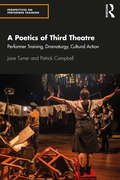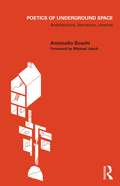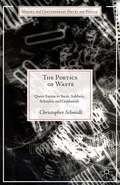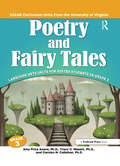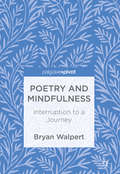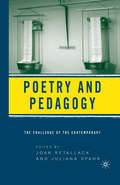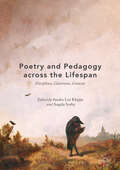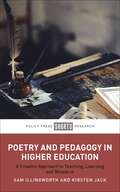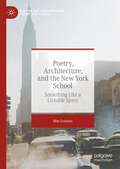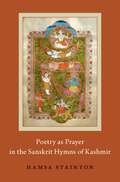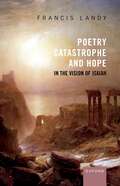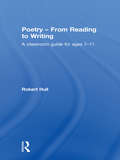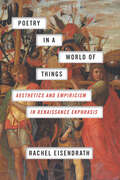- Table View
- List View
A Poetics of Third Theatre: Performer Training, Dramaturgy, Cultural Action (Perspectives on Performer Training)
by Jane Turner Patrick CampbellA Poetics of Third Theatre offers an in-depth, critical analysis of Third Theatre, a transnational community of theatre groups and artists united by a shared set of values and a laboratory attitude. This book takes a genealogical account of Third Theatre as a concept and a practice that draws attention to the historical Third Theatre Encounters that have taken place across Europe and Latin America since the 1970s. The work of renowned Third Theatre groups and organisations, such as LUME (Brazil), Grupo Cultural Yuyachkani (Peru), Triangle Theatre (UK) and Nordisk Teaterlaboratorium – NTL (Denmark), are explored to reveal how a multifarious poetics of Third Theatre is manifest through these artists’ approaches to performer training, dramaturgy and cultural action. Three critical pillars – unconditional hospitality, artisanal craft and (re)enchantment – are employed in order to illuminate the shared ethos of the Third Theatre community and its exemplification as a mode of cultural performance. This informative text will be of great use to students and scholars of drama and theatre studies, and its dedicated section on performer training exercises offers the reader pathways into an experiential engagement with Third Theatre craft.
Poetics of Underground Space: Architecture, Literature, Cinema
by Antonello BoschiThis book investigates the relationship architecture has with the underground. It provides a broad ranging historical and theoretical survey of, and critical reflection on, ideas pertaining to the creation and occupation of underground space. It overturns the classic dictates of construction on the surface and through numerous examples explores recoveries of existing voids, excavations, caves, quarries, grottos and burrows. The exploitation of land, especially in areas of particular value, has given rise to the need to reformulate the usual approach to building. If the development of urban sprawl, its infrastructure and its networks, generates increasingly compromised landscapes, what are the possible strategies to transform, expand and change the usual relationship between abuse of soil and unused subsoil? Psychological, philosophical, literary and cinematographic legacies of underground architecture are mixed with the compositional, typological and constructive expedients, to produce a rich, diverse and compelling argument for these spaces. As such, the book will appeal to architecture students, scholars and academics as well as those with an interest in literary theory, cinema and cultural studies.
Poetics of Underground Space: Architecture, Literature, Cinema
by Antonello BoschiThis book investigates the relationship architecture has with the underground. It provides a broad ranging historical and theoretical survey of, and critical reflection on, ideas pertaining to the creation and occupation of underground space. It overturns the classic dictates of construction on the surface and through numerous examples explores recoveries of existing voids, excavations, caves, quarries, grottos and burrows. The exploitation of land, especially in areas of particular value, has given rise to the need to reformulate the usual approach to building. If the development of urban sprawl, its infrastructure and its networks, generates increasingly compromised landscapes, what are the possible strategies to transform, expand and change the usual relationship between abuse of soil and unused subsoil? Psychological, philosophical, literary and cinematographic legacies of underground architecture are mixed with the compositional, typological and constructive expedients, to produce a rich, diverse and compelling argument for these spaces. As such, the book will appeal to architecture students, scholars and academics as well as those with an interest in literary theory, cinema and cultural studies.
The Poetics of Waste: Queer Excess in Stein, Ashbery, Schuyler, and Goldsmith (Modern and Contemporary Poetry and Poetics)
by C. SchmidtModernist debates about waste - both aesthetic and economic - often express biases against gender and sexual errancy. The Poetics of Waste looks at writers and artists who resist this ideology and respond by developing an excessive poetics.
Poetics, Politics and Protest in Arab Theatre: The Bitter Cup and the Holy Rain
by Masud HamdanThis book highlights the so far unappreciated merit of the Syrian playwrights Durayd Lahham and Muhammad al-Maghout, whose plays are representative of the new wave of Arab theatrical realisation in general and Syrian protest plays in particular. 'Ghawwar', the famous character type created by Lahham, combines art with politics, the past with modern times, lower class-consciousness and identity with Pan-Arab nationalism, and East with West. He also symbolizes a poetical link between the 'bitter cup' of a miserable present and the 'holy rain' of a better future.
Poetry and Fairy Tales: Language Arts Units for Gifted Students in Grade 3
by Amy Price Azano Tracy C. Missett Carolyn M. CallahanThe CLEAR curriculum, developed by University of Virginia's National Research Center on the Gifted and Talented, is an evidence-based teaching model that emphasizes Challenge Leading to Engagement, Achievement, and Results. In Poetry and Fairy Tales: Language Arts Units for Gifted Students in Grade 3 students will read and analyze various forms of poetry and write their own poetry anthology. They will learn how to identify and use figurative language to create concrete images from abstract ideas. In the fairy tales unit, students will study fairy tales and folklore to understand how and why societal norms and mores are culturally transmitted. These units focus on critical literacy that includes reading diverse sources, understanding bias and cultural contexts, and creating informed consumers of information.Grade 3
Poetry and Fairy Tales: Language Arts Units for Gifted Students in Grade 3
by Amy Price Azano Tracy C. Missett Carolyn M. CallahanThe CLEAR curriculum, developed by University of Virginia's National Research Center on the Gifted and Talented, is an evidence-based teaching model that emphasizes Challenge Leading to Engagement, Achievement, and Results. In Poetry and Fairy Tales: Language Arts Units for Gifted Students in Grade 3 students will read and analyze various forms of poetry and write their own poetry anthology. They will learn how to identify and use figurative language to create concrete images from abstract ideas. In the fairy tales unit, students will study fairy tales and folklore to understand how and why societal norms and mores are culturally transmitted. These units focus on critical literacy that includes reading diverse sources, understanding bias and cultural contexts, and creating informed consumers of information.Grade 3
Poetry and Mindfulness: Interruption to a Journey
by Bryan WalpertAt a time when the Humanities are under threat, this book offers a defense of poetry within the context of growing interest in mindfulness in business, health care, and education. The book argues that the benefits and insights mindfulness provides are also cultivated by the study of poetry. These benefits include a focus on the present, the ability to see through scripts and habits, a rethinking of subjectivity, and the development of ecological or systems thinking. Bryan Walpert employs close readings of traditional and experimental poetry and draws on scientific studies of the effects of mindfulness or reading literature on the brain. It argues the skills that poetry, like mindfulness, cultivates are useful beyond the page or classroom and ultimately are necessary to engage with such global issues as the environmental crisis.
Poetry and Mindfulness: Interruption to a Journey
by Bryan WalpertAt a time when the Humanities are under threat, this book offers a defense of poetry within the context of growing interest in mindfulness in business, health care, and education. The book argues that the benefits and insights mindfulness provides are also cultivated by the study of poetry. These benefits include a focus on the present, the ability to see through scripts and habits, a rethinking of subjectivity, and the development of ecological or systems thinking. Bryan Walpert employs close readings of traditional and experimental poetry and draws on scientific studies of the effects of mindfulness or reading literature on the brain. It argues the skills that poetry, like mindfulness, cultivates are useful beyond the page or classroom and ultimately are necessary to engage with such global issues as the environmental crisis.
Poetry and Pedagogy: The Challenge of the Contemporary
by J. Retallack J. SpahrThis anthology is a new reading of the contemporary poetries. The collection gathers together the work of a number of scholars, poets, and teachers on the challenges and productive possibilities that arise when teaching contemporary writing today.
Poetry and Pedagogy across the Lifespan: Disciplines, Classrooms, Contexts
by Sandra Lee Kleppe Angela SorbyThis book explores poetry and pedagogy in practice across the lifespan. Poetry is directly linked to improved literacy, creativity, personal development, emotional intelligence, complex analytical thinking and social interaction: all skills that are crucial in contemporary educational systems. However, a narrow focus on STEM subjects at the expense of the humanities has led educators to deprioritize poetry and to overlook its interdisciplinary, multi-modal potential. The editors and contributors argue that poetry is not a luxury, but a way to stimulate linguistic experiences that are formally rich and cognitively challenging. To learn through poetry is not just to access information differently, but also to forge new and different connections that can serve as reflective tools for lifelong learning. This interdisciplinary book will be of value to teachers and students of poetry, as well as scholars interested in literacy across the disciplines.
Poetry and Pedagogy in Higher Education: A Creative Approach to Teaching, Learning and Research
by Sam Illingworth Kirsten JackThis book invites us to consider the profound impact that poetry can have in shaping personal and professional development in a higher education setting. Suitable for educators, learners, and practitioners, it offers a transformative learning approach in using poetry for teaching, assessment, research, and reflection. The book includes diverse examples, case studies, and practical exercises, demonstrating poetry's application in personal and professional development in a higher education setting. Each chapter guides readers through these processes, empowering them to integrate poetry into their own teaching and learning practices in a way that is creative, inclusive, and impactful.
Poetry and Pedagogy in Higher Education: A Creative Approach to Teaching, Learning and Research
by Sam Illingworth Kirsten JackThis book invites us to consider the profound impact that poetry can have in shaping personal and professional development in a higher education setting. Suitable for educators, learners, and practitioners, it offers a transformative learning approach in using poetry for teaching, assessment, research, and reflection. The book includes diverse examples, case studies, and practical exercises, demonstrating poetry's application in personal and professional development in a higher education setting. Each chapter guides readers through these processes, empowering them to integrate poetry into their own teaching and learning practices in a way that is creative, inclusive, and impactful.
Poetry, Architecture, and the New York School: Something Like a Liveable Space (Modern and Contemporary Poetry and Poetics)
by Mae LosassoPoetry, Architecture, and the New York School: Something Like a Liveable Space examines the relationship between poetics and architecture in the work of the first generation New York School poets, Frank O’Hara, John Ashbery, Barbara Guest, and James Schuyler. Reappraising the much-debated New York School label, Mae Losasso shows how these writers constructed poetic spaces, structures, surfaces, and apertures, and sought to figure themselves and their readers in relation to these architextual sites. In doing so, Losasso reveals how the built environment shapes the poetic imagination and how, in turn, poetry alters the way we read and inhabit architectural space. Animated by archival research and architectural photographs, Poetry, Architecture, and the New York School marks a decisive interdisciplinary turn in New York School studies, and offers new frameworks for thinking about postmodern American poetry in the twenty-first century.
Poetry as Prayer in the Sanskrit Hymns of Kashmir (AAR Religion in Translation)
by Hamsa StaintonHistorically, Kashmir was one of the most dynamic and influential centers of Sanskrit learning and literary production in South Asia. In Poetry as Prayer in the Sanskrit Hymns of Kashmir, Hamsa Stainton investigates the close connection between poetry and prayer in South Asia by studying the history of Sanskrit hymns of praise (stotras) in Kashmir. The book provides a broad introduction to the history and general features of the stotra genre, and it charts the course of these literary hymns in Kashmir from the eighth century to the present. In particular, it offers the first major study in any European language of the Stutikusum=añjali, an important work of religious literature dedicated to the god 'Siva and one of the only extant witnesses to the trajectory of Sanskrit literary culture in fourteenth-century Kashmir. The book also contributes to the study of 'Saivism by examining the ways in which 'Saiva poets have integrated the traditions of Sanskrit literature and poetics, theology (especially non-dualism), and 'Saiva worship and devotion. It substantiates the diverse configurations of 'Saiva bhakti expressed and explored in these literary hymns and the challenges they present for standard interpretations of Hindu bhakti. More broadly, this study of stotras from Kashmir offers new perspectives on the history and vitality of prayer in South Asia and its complex relationships to poetry and poetics.
Poetry as Prayer in the Sanskrit Hymns of Kashmir (AAR Religion in Translation)
by Hamsa StaintonHistorically, Kashmir was one of the most dynamic and influential centers of Sanskrit learning and literary production in South Asia. In Poetry as Prayer in the Sanskrit Hymns of Kashmir, Hamsa Stainton investigates the close connection between poetry and prayer in South Asia by studying the history of Sanskrit hymns of praise (stotras) in Kashmir. The book provides a broad introduction to the history and general features of the stotra genre, and it charts the course of these literary hymns in Kashmir from the eighth century to the present. In particular, it offers the first major study in any European language of the Stutikusum=añjali, an important work of religious literature dedicated to the god 'Siva and one of the only extant witnesses to the trajectory of Sanskrit literary culture in fourteenth-century Kashmir. The book also contributes to the study of 'Saivism by examining the ways in which 'Saiva poets have integrated the traditions of Sanskrit literature and poetics, theology (especially non-dualism), and 'Saiva worship and devotion. It substantiates the diverse configurations of 'Saiva bhakti expressed and explored in these literary hymns and the challenges they present for standard interpretations of Hindu bhakti. More broadly, this study of stotras from Kashmir offers new perspectives on the history and vitality of prayer in South Asia and its complex relationships to poetry and poetics.
Poetry, Catastrophe, and Hope in the Vision of Isaiah
by Prof Francis LandyThe book of Isaiah is one of the longest and strangest books of the Hebrew Bible, composed over several centuries and traversing the catastrophe that befell the two kingdoms of Israel and Judah in the 8th and 6th centuries BCE. Francis Landy's book tells the story of the poetic response to catastrophe, and the hope for a new and perfect world on the other side. The study traces two parallel developments: the displacement of the Davidic promise onto the Persian Empire, Israel, and the prophet himself; and the transition from exclusively male images of the deity to the matching of male and female prototypes, whereby YHWH takes the place of the warrior goddess. Utopia, Catastrophe, and Poetry in the Book of Isaiah consists of close readings of individual passages in Isaiah, commencing with Chapter One and the problems of beginning, and ending with Deutero-Isaiah, composed subsequent to the Babylonian exile. The volume is arranged thematically as well as sequentially: the first chapter following the introduction concerns gender, the second death, the third the Oracles about the Nations. At the centre there is what Landy calls 'the constitutive enigma', Isaiah's commission in his vision to speak so that people will not understand. This renders the entire book potentially incomprehensible; the more we try to understand it, the greater the difficulty. For Landy, this creates a model of reading and writing, the challenge and the risk of going up blind alleys, of trying to make sense of a disastrous world. Isaiah's commission pervades the book. Throughout there is a promise of an age of clarity as well as social and political transformation, which is always deferred beyond the horizon. Hence it is a book without an ending, or with multiple endings. In the final chapters, the author turns to the central Chapter Thirty-Three, a mise-en-abyme of the book and a prayer for deliverance, and the issues of exile and the possibility of return. Like every poetic work, particularly in an era of cultural collapse, it is a critique of the past and a hope for a new humanity.
Poetry, Catastrophe, and Hope in the Vision of Isaiah
by Prof Francis LandyThe book of Isaiah is one of the longest and strangest books of the Hebrew Bible, composed over several centuries and traversing the catastrophe that befell the two kingdoms of Israel and Judah in the 8th and 6th centuries BCE. Francis Landy's book tells the story of the poetic response to catastrophe, and the hope for a new and perfect world on the other side. The study traces two parallel developments: the displacement of the Davidic promise onto the Persian Empire, Israel, and the prophet himself; and the transition from exclusively male images of the deity to the matching of male and female prototypes, whereby YHWH takes the place of the warrior goddess. Utopia, Catastrophe, and Poetry in the Book of Isaiah consists of close readings of individual passages in Isaiah, commencing with Chapter One and the problems of beginning, and ending with Deutero-Isaiah, composed subsequent to the Babylonian exile. The volume is arranged thematically as well as sequentially: the first chapter following the introduction concerns gender, the second death, the third the Oracles about the Nations. At the centre there is what Landy calls 'the constitutive enigma', Isaiah's commission in his vision to speak so that people will not understand. This renders the entire book potentially incomprehensible; the more we try to understand it, the greater the difficulty. For Landy, this creates a model of reading and writing, the challenge and the risk of going up blind alleys, of trying to make sense of a disastrous world. Isaiah's commission pervades the book. Throughout there is a promise of an age of clarity as well as social and political transformation, which is always deferred beyond the horizon. Hence it is a book without an ending, or with multiple endings. In the final chapters, the author turns to the central Chapter Thirty-Three, a mise-en-abyme of the book and a prayer for deliverance, and the issues of exile and the possibility of return. Like every poetic work, particularly in an era of cultural collapse, it is a critique of the past and a hope for a new humanity.
Poetry - From Reading to Writing: A Classroom Guide for Ages 7-11
by Robert HullPoetry – From Reading to Writing covers the process of writing poetry, from reading poems through to writing them. It is intended particularly for teachers at key stage 2 level, but other teachers will also find it valuable. It is clearly and accessibly written and jargon-free. In providing a wealth of practical ideas and activities preparing for the writing of poems, the book also stresses the use of talk, improvised drama and the reading and performance of poems. The author, who has published four collections of poetry, uses his own work and the work of others to explore how creative readings of poems can spark a child’s imagination and lead to original writing. Pupils are encouraged throughout the book to explore different forms of poetry, including: Rhyming and non-rhyming poems Riddles Short poems Haiku, tanka, renga Poems from stories Free verse Narrative poems Poems drawing on current affairs and history This book can be used by both pupils and teachers, and contains motivating tasks and tips to build pupils’ confidence in poetry writing. Explicit links are made throughout to the latest primary framework for literacy, making this an invaluable resource for all practising and trainee teachers who wish to teach poetry in the classroom in a creative and enjoyable way.
Poetry - From Reading to Writing: A Classroom Guide for Ages 7-11
by Robert HullPoetry – From Reading to Writing covers the process of writing poetry, from reading poems through to writing them. It is intended particularly for teachers at key stage 2 level, but other teachers will also find it valuable. It is clearly and accessibly written and jargon-free. In providing a wealth of practical ideas and activities preparing for the writing of poems, the book also stresses the use of talk, improvised drama and the reading and performance of poems. The author, who has published four collections of poetry, uses his own work and the work of others to explore how creative readings of poems can spark a child’s imagination and lead to original writing. Pupils are encouraged throughout the book to explore different forms of poetry, including: Rhyming and non-rhyming poems Riddles Short poems Haiku, tanka, renga Poems from stories Free verse Narrative poems Poems drawing on current affairs and history This book can be used by both pupils and teachers, and contains motivating tasks and tips to build pupils’ confidence in poetry writing. Explicit links are made throughout to the latest primary framework for literacy, making this an invaluable resource for all practising and trainee teachers who wish to teach poetry in the classroom in a creative and enjoyable way.
Poetry in a World of Things: Aesthetics and Empiricism in Renaissance Ekphrasis
by Rachel EisendrathWe have become used to looking at art from a stance of detachment. In order to be objective, we create a “mental space” between ourselves and the objects of our investigation, separating internal and external worlds. This detachment dates back to the early modern period, when researchers in a wide variety of fields tried to describe material objects as “things in themselves”—things, that is, without the admixture of imagination. Generations of scholars have heralded this shift as the Renaissance “discovery” of the observable world. In Poetry in a World of Things, Rachel Eisendrath explores how poetry responded to this new detachment by becoming a repository for a more complex experience of the world. The book focuses on ekphrasis, the elaborate literary description of a thing, as a mode of resistance to this new empirical objectivity. Poets like Petrarch, Spenser, Marlowe, and Shakespeare crafted highly artful descriptions that recovered the threatened subjective experience of the material world. In so doing, these poets reflected on the emergence of objectivity itself as a process that was often darker and more painful than otherwise acknowledged. This highly original book reclaims subjectivity as a decidedly poetic and human way of experiencing the material world and, at the same time, makes a case for understanding art objects as fundamentally unlike any other kind of objects.
Poetry in a World of Things: Aesthetics and Empiricism in Renaissance Ekphrasis
by Rachel EisendrathWe have become used to looking at art from a stance of detachment. In order to be objective, we create a “mental space” between ourselves and the objects of our investigation, separating internal and external worlds. This detachment dates back to the early modern period, when researchers in a wide variety of fields tried to describe material objects as “things in themselves”—things, that is, without the admixture of imagination. Generations of scholars have heralded this shift as the Renaissance “discovery” of the observable world. In Poetry in a World of Things, Rachel Eisendrath explores how poetry responded to this new detachment by becoming a repository for a more complex experience of the world. The book focuses on ekphrasis, the elaborate literary description of a thing, as a mode of resistance to this new empirical objectivity. Poets like Petrarch, Spenser, Marlowe, and Shakespeare crafted highly artful descriptions that recovered the threatened subjective experience of the material world. In so doing, these poets reflected on the emergence of objectivity itself as a process that was often darker and more painful than otherwise acknowledged. This highly original book reclaims subjectivity as a decidedly poetic and human way of experiencing the material world and, at the same time, makes a case for understanding art objects as fundamentally unlike any other kind of objects.
Poetry in a World of Things: Aesthetics and Empiricism in Renaissance Ekphrasis
by Rachel EisendrathWe have become used to looking at art from a stance of detachment. In order to be objective, we create a “mental space” between ourselves and the objects of our investigation, separating internal and external worlds. This detachment dates back to the early modern period, when researchers in a wide variety of fields tried to describe material objects as “things in themselves”—things, that is, without the admixture of imagination. Generations of scholars have heralded this shift as the Renaissance “discovery” of the observable world. In Poetry in a World of Things, Rachel Eisendrath explores how poetry responded to this new detachment by becoming a repository for a more complex experience of the world. The book focuses on ekphrasis, the elaborate literary description of a thing, as a mode of resistance to this new empirical objectivity. Poets like Petrarch, Spenser, Marlowe, and Shakespeare crafted highly artful descriptions that recovered the threatened subjective experience of the material world. In so doing, these poets reflected on the emergence of objectivity itself as a process that was often darker and more painful than otherwise acknowledged. This highly original book reclaims subjectivity as a decidedly poetic and human way of experiencing the material world and, at the same time, makes a case for understanding art objects as fundamentally unlike any other kind of objects.
Poetry in a World of Things: Aesthetics and Empiricism in Renaissance Ekphrasis
by Rachel EisendrathWe have become used to looking at art from a stance of detachment. In order to be objective, we create a “mental space” between ourselves and the objects of our investigation, separating internal and external worlds. This detachment dates back to the early modern period, when researchers in a wide variety of fields tried to describe material objects as “things in themselves”—things, that is, without the admixture of imagination. Generations of scholars have heralded this shift as the Renaissance “discovery” of the observable world. In Poetry in a World of Things, Rachel Eisendrath explores how poetry responded to this new detachment by becoming a repository for a more complex experience of the world. The book focuses on ekphrasis, the elaborate literary description of a thing, as a mode of resistance to this new empirical objectivity. Poets like Petrarch, Spenser, Marlowe, and Shakespeare crafted highly artful descriptions that recovered the threatened subjective experience of the material world. In so doing, these poets reflected on the emergence of objectivity itself as a process that was often darker and more painful than otherwise acknowledged. This highly original book reclaims subjectivity as a decidedly poetic and human way of experiencing the material world and, at the same time, makes a case for understanding art objects as fundamentally unlike any other kind of objects.
Poetry in a World of Things: Aesthetics and Empiricism in Renaissance Ekphrasis
by Rachel EisendrathWe have become used to looking at art from a stance of detachment. In order to be objective, we create a “mental space” between ourselves and the objects of our investigation, separating internal and external worlds. This detachment dates back to the early modern period, when researchers in a wide variety of fields tried to describe material objects as “things in themselves”—things, that is, without the admixture of imagination. Generations of scholars have heralded this shift as the Renaissance “discovery” of the observable world. In Poetry in a World of Things, Rachel Eisendrath explores how poetry responded to this new detachment by becoming a repository for a more complex experience of the world. The book focuses on ekphrasis, the elaborate literary description of a thing, as a mode of resistance to this new empirical objectivity. Poets like Petrarch, Spenser, Marlowe, and Shakespeare crafted highly artful descriptions that recovered the threatened subjective experience of the material world. In so doing, these poets reflected on the emergence of objectivity itself as a process that was often darker and more painful than otherwise acknowledged. This highly original book reclaims subjectivity as a decidedly poetic and human way of experiencing the material world and, at the same time, makes a case for understanding art objects as fundamentally unlike any other kind of objects.
